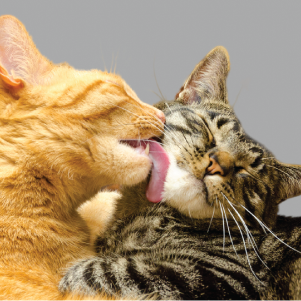
Do Cats Recognize Their Name? A Happy Cat Expert Explains
It is well known that dogs have a remarkable ability to understand a variety of spoken words, commands, and intonation of voice from humans. Along with this, they can readily discriminate between different human voices.(1-4) But how do cats’ voice recognition skills fair alongside their canine counterparts? Do cats recognize their names too? Let’s explore this fascinating subject in further detail.
Can Cats Understand Humans?
As early as 1912 (5) it was shown that cats have the ability to recognize and respond to their names being called by different humans. As well as this, they were also able to recognize other verbal communications. However, the ability of cats to recognize and understand the human voice, and how this is used, has been poorly investigated and understood.
2013 Study Into Cat Voice Recognition
A study published in 2013 (6) looked specifically at whether cats could recognize and distinguish their owner’s voice from other human voices.
To ensure fair results, this study took place with 20 cats in their home environments. First, the owners of these cats were recorded calling their cat’s name. Next, four strangers of the same sex were also recorded calling the cats’ names. While no one else was in the room, the cats were then played a recording of these voices, beginning with the strangers’ voices and then followed by their owner’s. A video camera was used to record their reactions.

In this study into cat voice recognition, the cats mainly responded to their name being called with ear and head movements, while less than one in five showed tail movement or vocalization. Interestingly, the results showed the cats seemed to recognize and respond to the voice of a stranger calling their name. However, they responded to a greater extent when it was the owner’s voice calling the cat.
Importantly, this study demonstrated that cats can understand humans, at least to an extent, and that they can discriminate between different human voices even in the absence of any visual cues. That said, it could not be determined whether cats do recognize their names.
More Recent Studies Into Cat Recognition Behavior
In a separate, more recent study (7), the same group of researchers were at last able to demonstrate that cats do recognize names. This was demonstrated by cats distinguishing human voices calling their own name from voices calling other cats names or other words. This was found to be the case with voices belonging to both the cats’ owners as well as strangers, and showed that cats not only recognize their owner’s voice but also respond to specific words, such as their name being called.

In a further study published very recently (8), an even greater ability of cats to recognize names was demonstrated. Using photographs displayed on a laptop screen, cats were shown images of other familiar cats, such as those living in the same house, or their human family members. At the same time, either the cat’s owner or a stranger would call out different names, some of which matched the cats and humans in the photos and some that did not.
The results of this study into cat recognition were fascinating. They showed that, when the names called out did not match the picture, the cats spent longer looking at the picture on the screen than when the name and image did match. This strongly suggested that the cats were aware the image did not correspond with the correct name being called. Interestingly, with the mismatching of family members, the cat’s recognition of the mismatch appeared to increase when there was a greater number of family members in the house and when the cat had been living in the house for a greater length of time.
These results suggest a surprisingly high level of social cognition among cats. Not only that, but cats also have the ability to learn, through observation, of the association between names and individuals for other cats and humans in their environment.

Understanding Cat Voice Recognition
These and other studies demonstrate fascinating insights into the cognitive abilities of cats and their interactions with humans. The ability of cats, and perhaps also their desire, to understand human vocal communication is probably nowhere near as sophisticated as dogs. However, the more subtle responses often shown by cats suggests we have also underestimated their abilities in the past. Using more advanced study designs that can identify these subtle responses, we are now beginning to understand the breadth and depth of a cat’s ability to recognize human voices.
It will come as no surprise to most cat owners that cats can recognize their names and owners’ voices. Few of us, however, would have known that cats could also show the ability to recognize the names of other cats and humans. This does indeed suggest that cats show advanced social awareness, presumably learning through observing social interactions around them. As we explore these aspects of cognition in cats, as is so often the case, we find that cats are much more sophisticated and complex in their relationships with humans than is often assumed.
Would you like to learn more about how cats learn and explore the world around them? Check out our other Happy Cat Expert articles covering a wide range of topics, from studies into how cats experience taste to tips on training! You can also stay up to date with our latest advice and guides, as well as receive information on all our FELIWAY products, by signing up to our newsletter.
References and further reading
- Smarter Than You Think. https://www.apa.org/news/press/releases/2009/08/dogs-think
- Ramos D, Ades C. Two-item sentence comprehension by a dog (Canis familiaris). PLoS One. 2012;7(2):e29689. doi: 10.1371/journal.pone.0029689.
- Smart Dogs: Canine Word-learning Research Yields Surprising Findings About Human Speech Comprehension. https://www.sciencedaily.com/releases/2004/06/040611072744.htm
- Root-Gutteridge H, et al (2019) Dogs perceive and spontaneously normalize formant-related speaker and vowel differences in human speech sounds.Biol. Lett. 15: 20190555. 20190555 http://doi.org/10.1098/rsbl.2019.0555
- Shepherd WT (1912) The Discrimination of Articulate Sounds by Cats. American Journal of Psychology 23(3):461-463
- Saito, A., Shinozuka, K. Vocal recognition of owners by domestic cats (Felis catus). Anim Cogn 16, 685–690 (2013). https://doi.org/10.1007/s10071-013-0620-4
- Saito, A., Shinozuka, K., Ito, Y. et al. Domestic cats (Felis catus) discriminate their names from other words. Sci Rep 9, 5394 (2019). https://doi.org/10.1038/s41598-019-40616-4
- Takagi, S., Saito, A., Arahori, M. et al. Cats learn the names of their friend cats in their daily lives. Sci Rep 12, 6155 (2022). https://doi.org/10.1038/s41598-022-10261-5
























